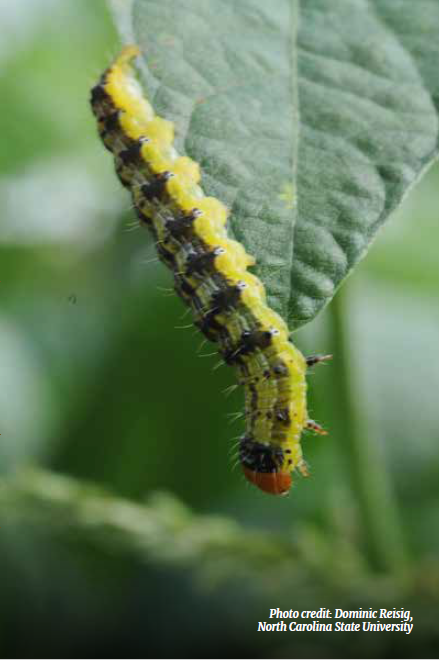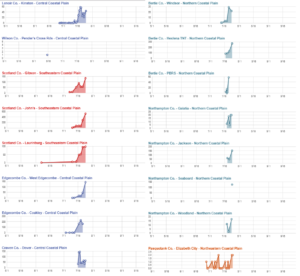As much of the soybean crop begins to move into reproductive stages, it’s time to start scouting for pod feeding insects.
Our common pod feeding insects include corn earworm and stink bugs. In some areas of the state, stink bugs seem to be a real problem this year. And, corn earworm traps across the state (https://ipm.ces.ncsu.edu/trap-data/) are showing an increase in numbers of the pest collected over the last week.
Corn Earworm
 Corn earworm may feed on soybean foliage, flowers, or pods, but the most serious yield losses occur when large corn earworm larvae feed on almost mature soybean seed. Thresholds for corn earworm depend on row width, price of beans, price of treatment, and sampling method used. This online calculator is useful for determining if an insecticide is needed. Pyrethroids have most commonly been used to control corn earworm but, there is evidence we have more resistance to pyrethroids than normal this year. There have been some reports of pyrethroid spray failures across the state and moths in Georgia and Virginia have tested more resistant to pyrethroids than normal. While pyrethroids will work well in many areas, if you are worried about pyrethroid resistance or have noticed spray failures, a worm-specific material like Blackhawk, Intrepid Edge, Prevathon, or Steward would an option.
Corn earworm may feed on soybean foliage, flowers, or pods, but the most serious yield losses occur when large corn earworm larvae feed on almost mature soybean seed. Thresholds for corn earworm depend on row width, price of beans, price of treatment, and sampling method used. This online calculator is useful for determining if an insecticide is needed. Pyrethroids have most commonly been used to control corn earworm but, there is evidence we have more resistance to pyrethroids than normal this year. There have been some reports of pyrethroid spray failures across the state and moths in Georgia and Virginia have tested more resistant to pyrethroids than normal. While pyrethroids will work well in many areas, if you are worried about pyrethroid resistance or have noticed spray failures, a worm-specific material like Blackhawk, Intrepid Edge, Prevathon, or Steward would an option.
Stink Bugs
Stink bugs infestations typically occur later than corn earworm, from late August to early October. Stink bugs feed on tender terminals, blooms, pods, and developing seeds with their piercing mouth parts. Thresholds for stink bugs are based on row width, price of beans, and sampling method used. This online calculator is useful for determining if an insecticide is needed. Acephate and pyrethroids (with bifenthrin the preferred pyrethroid) can be used for control of stink bugs. Since stink bugs are typically a late season pest, be aware of the pre-harvest interval of the insecticides you use.
Scouting
Two different methods can be used to sample for these pod feeders, a shake cloth or a sweep net. A shake cloth (or beat cloth) is easiest to use in rows greater than 30 inches. The videos below demonstrate how to use each of these methods.
Remember scouting for insects involves more than just riding by your fields. Get your sweep net or beat cloth and get in out in the field so you have a real idea of the insect populations present.









